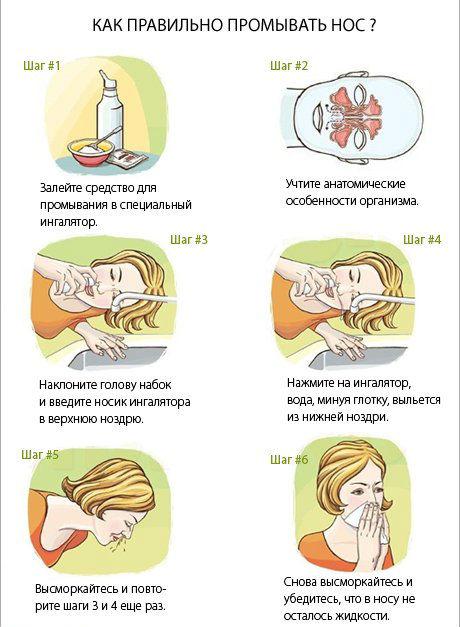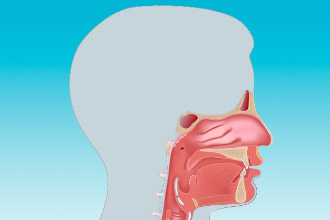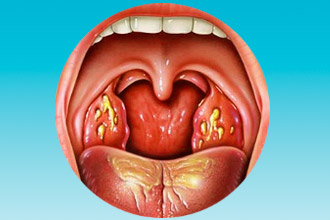Snot in the throat can occur as a symptom of various diseases of the respiratory, gastrointestinal tract, allergies, or be present as a physiological state of the body. A specialist can determine the causes of the accumulation of mucus in the throat after a series of examinations. It is important to pay attention to other symptoms to guess the cause of the condition.
Why does mucus build up in my throat?
The sensation of a lump in the throat may appear due to the influence of local irritants or pathological conditions of a general nature. Accumulation of snot on back wall a child's throat may be normal. In infants, mucus flows down the throat due to physiological characteristics the structure of the nasal passages (narrow lumen) and the inability to blow your nose or cough it up.
Mucus in the throat often flows from the nasal cavity.
The main reasons for the accumulation of mucus on the back of the pharynx in adults and children over a year old include:
- Irritation of the mucous membrane of the nasopharynx and oropharynx with polluted air, smoking, spicy hot food, alcoholic beverages, local medication (sprays, lozenges). When exposed to these factors, the mucous membrane is "protected" by increased production of mucus and its accumulation at the site of irritation. The sensation of a lump between the nose and throat continues until the irritating factor is eliminated.
- Respiratory tract diseases - chronic bronchitis, tonsillitis, pneumonia, rhinitis. In this case, the secret can be released in the form of green snot or clots, if the process has a bacterial etiology. In the chronic form of rhinitis, snot accumulates in the throat constantly.
- Inflammation of the sinuses (sinusitis, frontal sinusitis, ethmoiditis, sinusitis). Inflammatory process characterized by increased production of mucus and a violation of its excretion, which provokes an accumulation thick snot between the nose and throat.
- Diseases of the digestive tract. Stagnation of mucus in the pharynx is more characteristic of problems with the esophagus.
- Allergy. Most often, snot accumulates in the throat when exposed to local exposure to an allergen (dust, wool, pollen) inhaled with air.
- Rhinitis medication. It is caused by prolonged use of vasoconstrictor nasal drops, which lead to hypertrophy of the nasal mucosa. In this condition, snot practically does not cough up, nasal breathing is difficult.
- Hormonal changes. Overproduction and accumulation of mucus can occur against the background of endocrine diseases, during hormonal changes during adolescence and pregnancy.
- Nasopharyngeal neoplasms (polyps, tumors), curvature of the nasal septum. The patient is being tortured persistent snotthat make it difficult or completely block nasal breathing.
Chronic sinusitis often causes mucus to accumulate in the nasopharynx
 Signs of mucus accumulation in the nasopharynx
Signs of mucus accumulation in the nasopharynx
The following signs indicate a violation of mucus transport:
- feeling of a lump in the throat;
- sore or burning sensation in the throat;
- discomfort in the throat area;
- constant desire to clear your throat;
- difficulty swallowing.
Clots of snot cause a lot of inconvenience, in particular:
- disrupt normal breathing;
- interfere with food intake;
- cause bad breath or a specific taste.
If mucus stagnation is caused by non-infectious factors, and local mechanical or chemical stimuli, the accumulated mucus is transparent, expectorated, and has a thin consistency. The general condition of the patient does not change.
You can suspect the infectious origin of snot in the throat by the following signs:
- violation of the general condition (fever, weakness, chills, malaise);
- change in consistency, smell of secreted secretions.
What to do if mucus collects in the throat?
With the above symptoms, you should consult an otolaryngologist. After the examination, the doctor can prescribe additional examinations, consultations, or immediately prescribe treatment.
Possible consultations:
- allergist-immunologist,
- gastroenterologist,
- infectious disease specialist.
Additional examinations:
- general blood analysis;
- a blood test for antibodies to viruses;
- bacterial culture and microscopy of a nasopharyngeal smear;
- allergy tests;
- rhinoscopy;
- endoscopy of the nasopharynx.
The first person to visit for symptoms of mucus in the throat is an ENT doctor.
How to cure stagnant mucus in your throat
The treatment strategy depends on the cause of the congestion of mucus in the nasopharynx. To get rid of this unpleasant phenomenon, you must adhere to an integrated approach. First of all, patients are shown etiotropic treatment aimed at eliminating the cause of the disease.
Medications for etiotropic therapy include:
Medication depends entirely on the cause of the discomfort.
Simultaneously with the main one, symptomatic treatment is carried out aimed at eliminating the signs of the disease. To remove a lump in the throat, you can use flushes. The procedure allows not only to liquefy and remove snot that is stuck in the throat, but also to dry the mucous membrane
To prepare the solution, you can use:
- soda,
- potassium permanganate,
- sea \u200b\u200bsalt,
- furacilin,
- decoction of chamomile or sage.
How to rinse correctly: step by step instructions
- Take a syringe without a needle or a syringe, fill with a rinsing solution.
- Insert the tip into one nostril.
- Lean over the sink.
- Introduce the contents of the syringe into the nostril under pressure.
- If done correctly, the solution will wash the nasopharynx and exit the other nostril.
- Repeat the manipulation 2-3 times.
For rinsing the nose, you can use ready-made saline solutions (Humer, Aquamaris), which are available as a spray.
Folk recipes
- Drink plenty of fluids. 8 glasses of water per day is enough liquid to remove toxins from the body and thin phlegm.
- Inhaling with eucalyptus oil will help get rid of snot that collects in your throat.
- Eating gruel from crushed aloe leaves with honey in the morning and evening.
- A mixture of dried calendula flowers with honey inside.
Sputum is a viscous mucus that is produced by the glands of the mucous membranes of the bronchi and trachea. It contains immunocompetent cells - lymphocytes and macrophages, which prevent the multiplication of pathogens in the respiratory tract. The secret, dense in consistency, promotes the elimination (destruction) of foreign particles, metabolites, cellular detritus, which are evacuated from the respiratory system in the process of mucociliary cleansing. Why does mucus accumulate in the throat?
Mucus hypersecretion is a pathological symptom indicating the development of disorders in respiratory system... The accumulation of viscous secretion in the pharynx may be associated with the negative influence of exogenous and endogenous factors.
In the presence of pathological processes in the airways, the volume of secreted sputum can increase several times.
The mechanism of development of pathology
Why does mucus accumulate in my throat? Septic inflammation is one of the key causes of hypersecretion and accumulation of phlegm in the airways. In the absence of pathological processes, the volume of tracheobronchial mucus, separated per day, does not exceed 100 ml. Catarrhal inflammation in the ENT organs stimulates the production of secretions with bactericidal properties, as a result of which the volume of sputum can increase to ½ l.
Colorless mucus is produced by goblet cells, which are located in the ciliated epithelium. It prevents drying out of the mucous membranes and the penetration of pathogenic agents into the tissues. Sputum is produced not only by the tracheobronchial tree, but also by the nasopharynx. An increase in its volume is associated with the development of infections, exposure to allergens and penetration alien bodies inside the respiratory system.
Sputum hypersecretion is the body's natural response to the influence of pathological exogenous and endogenous factors.
Provoking factors
What to do if mucus builds up in the throat? The reasons for the increased activity of ciliated epithelium cells lie in the development of infectious and non-infectious pathologies. It is possible to determine the optimal treatment regimen for diseases only after passing differential diagnosis and diagnosis.
The main factors provoking the accumulation of viscous secretions in the airways include:
- allergens - irritate the mucous membrane of the nasopharynx, as a result of which an excess amount of mucus begins to be produced in the nasopharynx;
- neoplasms - stimulate the secretory activity of goblet cells, which subsequently leads to an increase in the volume of sputum in the throat;
- microorganisms - violate the functional activity of the ciliated epithelium and stimulate sputum production by the tracheobronchial tree;
- pathology of the gastrointestinal tract - the duodenal contents of the stomach, penetrating into the upper parts of the esophagus, irritate the ciliated epithelium, which stimulates the activity of the goblet cells.
Why does phlegm constantly collect in the throat? The reasons for the hyperactivity of the mucous membranes of the ENT organs are often due to the negative effects of tobacco smog, chemicals, dusty or dry air. All these factors have a destructive effect on the state of the tissues of the respiratory tract, which stimulates the production of mucus in large volumes.
The nature of the sputum

Mucous discharge is odorless, however, in the case of the development of septic inflammation, the occurrence of a putrid odor is not excluded. Constant phlegm in the throat is not a separate pathology, but only a symptom indicating the development of certain diseases. You can determine the type of pathology by the color and consistency of mucus that is expectorated when coughing:
- mucous - transparent, odorless sputum of moderate density, which occurs against the background of the development of pathologies of the respiratory tract;
- serous - colorless, liquid and frothy mucus that appears with obstruction of the lungs;
- mucopurulent - offensive sputum of a yellow or green hue, resulting from the development of tuberculosis, pneumonia, chronic bronchitis etc.;
- purulent - mucus of a semi-liquid consistency with an unpleasant odor, which is most often formed with purulent bronchitis, abscess of ENT organs, gangrene of the lungs, etc.
Important! Some ENT diseases can proceed in an atypical form, therefore, to find out the type of pathology only by consistency and accompanying clinical manifestations it is impossible.
It should be understood that the exact cause of mucus in the throat can only be determined by a competent specialist after visual and instrumental examination of the patient. It is possible to judge the development of septic or aseptic inflammation in the respiratory organs only by the results of bacterial culture and local manifestations of the disease.
Infectious causes

Why does phlegm form in the throat? The causes of hypersecretion of mucus in the pharynx are most often associated with the development of septic inflammation. Disease-causing fungi, viruses and microbes that enter the body cause inflammation in the nasal cavity, throat, bronchi, trachea, etc. To eliminate pathological reactions in tissues, goblet cells begin to function in an enhanced mode, which leads to the accumulation of viscous secretions in the airways.
As a rule, the sensation of a mucous lump in the pharynx occurs against the background of the development of pathologies such as:
- sinusitis - catarrhal or purulent inflammation of the paranasal sinuses, accompanied by profuse mucus from the nasal passages;
- tonsillitis–Septic inflammation of the tissues of the pharyngeal ring, in which the tonsils, pharynx and posterior pharyngeal wall are most often affected; depending on the form of the disease, during expectoration, transparent or greenish sputum is evacuated from the ENT organs, which indicates the development of bacterial inflammation;
- adenoiditis–Growth and inflammation of the nasopharyngeal tonsil, an increase in the volume of which prevents the normal expectoration of mucus that forms on the walls of the airways;
- bronchitis–Viral or bacterial inflammation of the tissues of the bronchial tree, which leads to impaired drainage function of the lungs and, accordingly, the accumulation of pathological secretions in the pharynx;
- tracheitis–Catarrhal or purulent inflammation of the trachea, characterized by hyperactivity of the goblet cells of the mucous epithelium, as a result of which viscous mucus begins to collect in the ENT organs;
- pneumonia – infectious lesion lung tissue with predominant inflammation of the alveoli, which leads to exudation;
- nasopharyngitis - catarrhal inflammation of the mucous epithelium of the nasopharynx and throat, accompanied by the formation of an excess amount of exudate in the respiratory organs;
- pharyngitis - an infectious lesion of the lymphoid tissues of the pharynx and mucous membranes of the throat, in which a moderate amount of sputum begins to accumulate in the respiratory tract.
Pathologies of the broncho-pulmonary system are treated mainly in a hospital setting, since many of them lead to the development of formidable complications.
Before prescribing medications, the specialist must conduct a comprehensive examination of sputum, bronchoscopy, radiography, etc. Therapy involves the use of an integrated approach, which ensures not only the elimination of inflammatory reactions in the respiratory organs, but also the normalization of the drainage function of the bronchi.
Non-infectious causes 
Why does mucus collect in my throat? It should be understood that active secretion of sputum is a protective reaction that occurs as a result of septic or aseptic inflammation of the mucous epithelium. Extrapulmonary pathologies and allergic reactions to exposure to exogenous stimuli can provoke sputum hypersecretion.
Excessive mucus formation in the ENT organs is often associated with:
- allergic rhinitis - catarrhal inflammation of the nasopharyngeal mucosa, which is associated with an allergic reaction of tissues to the influence of allergens (dust, animal hair, pollen); pathological secretion accumulated in the nasopharynx flows down the back of the throat, which causes coughing and lacrimation;
- mucosal injuries - mechanical and chemical injuries lead to damage to the ciliated epithelium, resulting in inflammation and, accordingly, excessive sputum formation in the respiratory organs;
- gastroesophageal reflex - Throwing gastric juice into the upper esophagus leads to burns on the walls of the pharynx, which inevitably leads to increased secretion of viscous mucus;
- eating spicy food - hot and spicy food irritates the mucous membrane of the oropharynx, which stimulates an increase in the amount of pathological secretions in the ENT organs;
- smoking - the systematic effect of tobacco smog on the respiratory tract leads to tissue atrophy and disruption of the process of mucus secretion by goblet cells.
Coughing up a viscous secretion streaked with blood may indicate the development of pulmonary embolism, which leads to cardiac arrest.
Delayed treatment of pathologies threatens the patient with serious systemic complications and even death. Therefore, when the first signs of pathology are found, it is necessary to undergo an examination by a specialist. It should be noted that goblet cell hyperactivity may be associated with the development of benign and malignant tumors. Inadequate treatment of cancer often leads to pharyngeal stenosis and suffocation.
When to see a doctor? 
A feeling of a lump in the throat, difficulty swallowing and wheezing in the respiratory organs most often indicates the presence of an excess amount of viscous secretion in the throat. Symptoms may worsen in the morning or immediately after a meal. It is undesirable to postpone a visit to a specialist if the following pathological signs are found:
- sore throat and burning sensation;
- sputum running down the walls of the pharynx;
- cough with expectoration of viscous secretion;
- inability to swallow or cough up mucus;
- fetid odor from the mouth;
- the formation of excess mucus in the nose.
If the hyperactivity of the ciliated epithelium is due to septic inflammation of the ENT organs, hyperthermia, fever, malaise, nausea, myalgia, etc. will join the symptoms of pathology. When a similar clinical picture appears, it is worth seeking help from a doctor. Only in this case, the patient can be prescribed the necessary drugs of symptomatic and pathogenetic action.
